QUESTION 1 Which ecological niche described below possesses
QUESTION 1
Which ecological niche described below possesses the greatest number of prokaryotic cells (select one)?
A.
Oceanic and Terrestrial sub-surfaces
B.
In or on non-prokaryotic organisms (humans, animals and plants)
C.
Dry land
D.
Lakes, rivers and oceans
E.
Earth stratosphere
1 points Saved
QUESTION 2
Which organism was primarily responsible for oxygenation of the earth approximately 2 billion years ago (select one)?
A.
cyanobacteria
B.
Wooly mammoths
C.
Green sulfur bacteria
D.
Thermophilic archaea
E.
algae
1 points Saved
QUESTION 3
The earliest microorganisms were likely restricted to deep ocean and sub-surface ecological niches until which of the following (select one)?
A.
Ozone layer developed
B.
Aquatic life carried them to land
C.
Phototrophy evolved
D.
Chemolithotrophy developed
E.
The development of chemoorganotrophy
1 points Saved
QUESTION 4
Two tubes are inoculated from one test tube of a bacterial culture. The cultures are then transferred every day for 2 months. All of the media and growth conditions are the same in every tube. After 2 months of cultivation, the fitness and genotype frequencies of the populations in the two tubes are compared. The fitness of the two cultures is the same, but the genotype frequencies are very different in the two cultures. How is this possible?
A.
This result is not possible because different genotype frequencies would result in different fitness levels under the same growth conditions.
B.
Genetic drift within the small populations in the test tubes resulted in different genotype frequencies.
C.
It is highly unlikely that any bacterial culture could be maintained for 2 months
D.
Natural selection caused the evolution of different genotype frequencies within the separate test tubes.
E.
Two months is not long enough for different fitness levels to evolve even if the genotype frequencies change.
1 points Saved
QUESTION 5
If you allowed 20 identical parallel Listeria cultures to evolve for 20,000 generations under new growth conditions with very little nitrogen, the parallel cultures would do which of the following (select one)?
A.
Direct mutations to occur in nitrogen utilization and uptake genes in order to adapt rapidly to the culture conditions
B.
Each parallel culture would accumulate different random mutations resulting in different adaptations to use the nitrogen in the media.
C.
Evolve identical adaptations to use the nitrogen source provided in the media
D.
Not change or adapt significantly over this small number of generations
E.
Each culture would evolve to use arsenic in place of nitrogen
1 points Save Answer
QUESTION 6
Which of the following statements are correct about the early formation of life on earth (select all that apply)?
A.
Lateral gene transfer is one plausible explanation as to why organisms in Archaea, Bacteria, and Eukarya still share so many genes among such distinct domains.
B.
The domains of life arose as barriers between gene exchange evolved between organisms
C.
When the first microbial cells arose, the earth had an oxidizing atmosphere
D.
The oxygenation of the earth was a driving factor in the formation of eukaryotic cells
E.
The establishment of DNA as the genome of the cell likely evolved due to a need to store genetic information in a more stable form than RNA
2 points Saved
QUESTION 7
Bacteria can evolve through genome mutations, insertions and deletions. If bacteria lost the ability to accrue gene deletions, what would be the consequences over time? Why? (limit 4-5 sentences).
Path: pWords:104
2 points Saved
QUESTION 8
Which of the following statements are correct about the evolution of prokaryotic genomes (select all that apply)?
A.
The pan genome is always larger than the core genome of a species
B.
Two bacteria in the same species will have the same number of genes (within 5%)
C.
Horizontal gene transfer is a major explanation for differences in pan genomes within the same species
D.
There are approximately 50-250 universal genes present in all Bacteria and Archaea
E.
Prokaryotic genomes do not evolve, only plasmids transferred between prokaryotes evolve
2 points Saved
QUESTION 9
You have isolated a bacterium from an environmental sample. The microbe has the ability to rapidly degrade hydrocarbons found in oil spills, so you are excited that it could be a new species. What experiments should you perform to determine if your isolate is truly a new species? What process will you follow to officially name your isolate (Limit 5-6 sentences)?
Path: pWords:0
2 points Saved
QUESTION 10
[x] is the theory depicted in the figure below for the origin of Eukaryotes.
ES Theory
the origen and early evolution
2 points Saved
QUESTION 11
The figure below contains 16s rRNA sequence alignments of enterococcal species of bacteria and a novel bacterium (#1441) isolated from a patient with intestinal disease. Order the different species from most phylogentically-related to least related to the novel #1441 isolate. Not that a - indicates the sequence is the same at #1441.
16s RNA Alignments
E. cecorum
E. sulfereous
E seriolichida
E. columbae
E. faecalis
2 points Save Answer
QUESTION 12
Energy yielding reactions between which of the following are thought to have driven the metabolism of the earliest (most primitive organisms) (select one)?
A.
H2 and glucose
B.
O2 and H2
C.
Fe, O2 and H2
D.
H2 and So
E.
H2, O2 and So
1 points Saved
QUESTION 13
A common cause of respiratory infections is the bacterium Streptococcus pneumoniae. You are able to culture bacteria from five different patients suffering from respiratory infections and determine 16s rRNA gene sequences as well as perform genomic hydridization experiments with a standard isolate of Streptococcus pneumoniae (Data below). In the absence of additional phylogenetic and sequence data, which clinical isolates would you conclude are from the same species as the standard Streptococcus pneumoniae sample (select all that apply)?
Patient 16s RNA
Similarity Genomic
DNA:DNA
A 100% 86%
B 98% 65%
C 99% 72%
D 93% 74%
E 50% 68%
A.
Patient A
B.
Patient B
C.
Patient C
D.
Patient D
E.
Patient E
2 points Saved
QUESTION 14
Extra Credit
Under aerobic conditions, E coli cannot use citrate as an energy source. In the Long Term Evolution of E coli experiment described in Figure 12.22 of our textbook, E coli grown aerobically in the presence of glucose and citrate eventually evolved the ability to utilize citrate as an energy source after 30,000 generations. Which of the following statements best describes the genetic change that occurred that enabled growth on citrate (select one)? Note you will have to research the scientific literature to answer this question.
A.
Transcription of a citrate transporter is normally repressed under aerobic conditions, but a gene duplication resulted in constitutive expression of the citrate transporter.
B.
A gene in the involved in metabolism of glucose is deleted
C.
A gene involved in fermentation of glucose was mutated so that the culture had to use citrate as an energy source
D.
Enzyme involved in citrate metabolism is mutated
E.
The strain of E coli able to utilize citrate acquired a citrate metabolism enzyme from another bacteria by horizontal gene transfer
Solution
1.A Oceanic and Terrestrial sub-surfaces
The greatest numbers are in the subsurface, soil and oceans.Prokaryotes are extraordinarily diverse and range from plant-like cells that produce molecular oxygen in the oceans to soilborne bacteria responsible for fertility.
2. A.cyanobacteria
Oceanic cyanobacteria,which evolved into multicellular forms more than 2.3 billion years ago are believed to have become the first microbes to produce oxygen by photosynthesis.
3.C phototrophy evolved
4. b.Genetic drift within the small populations in the test tubes resulted in different genotype frequencies.
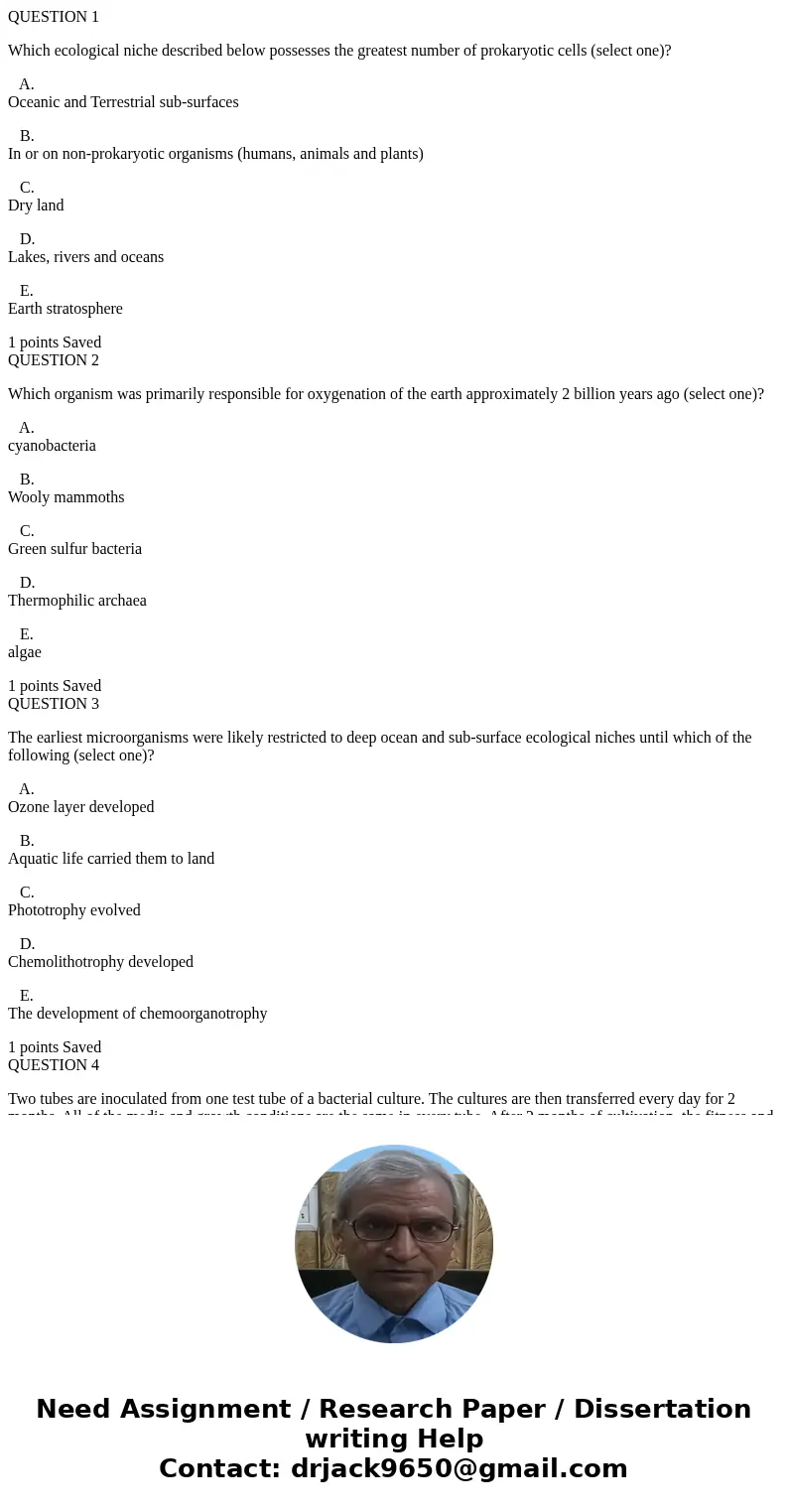
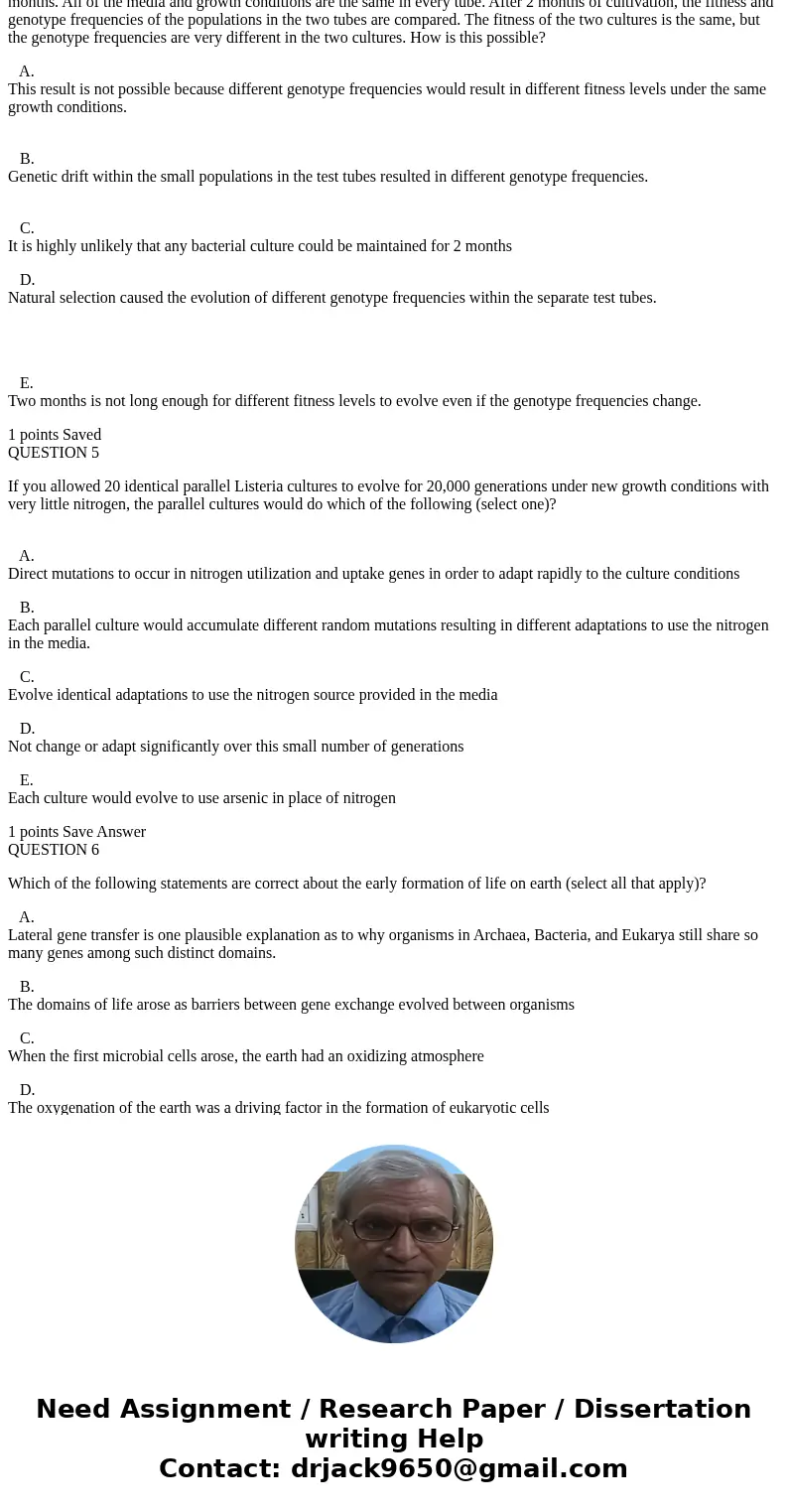
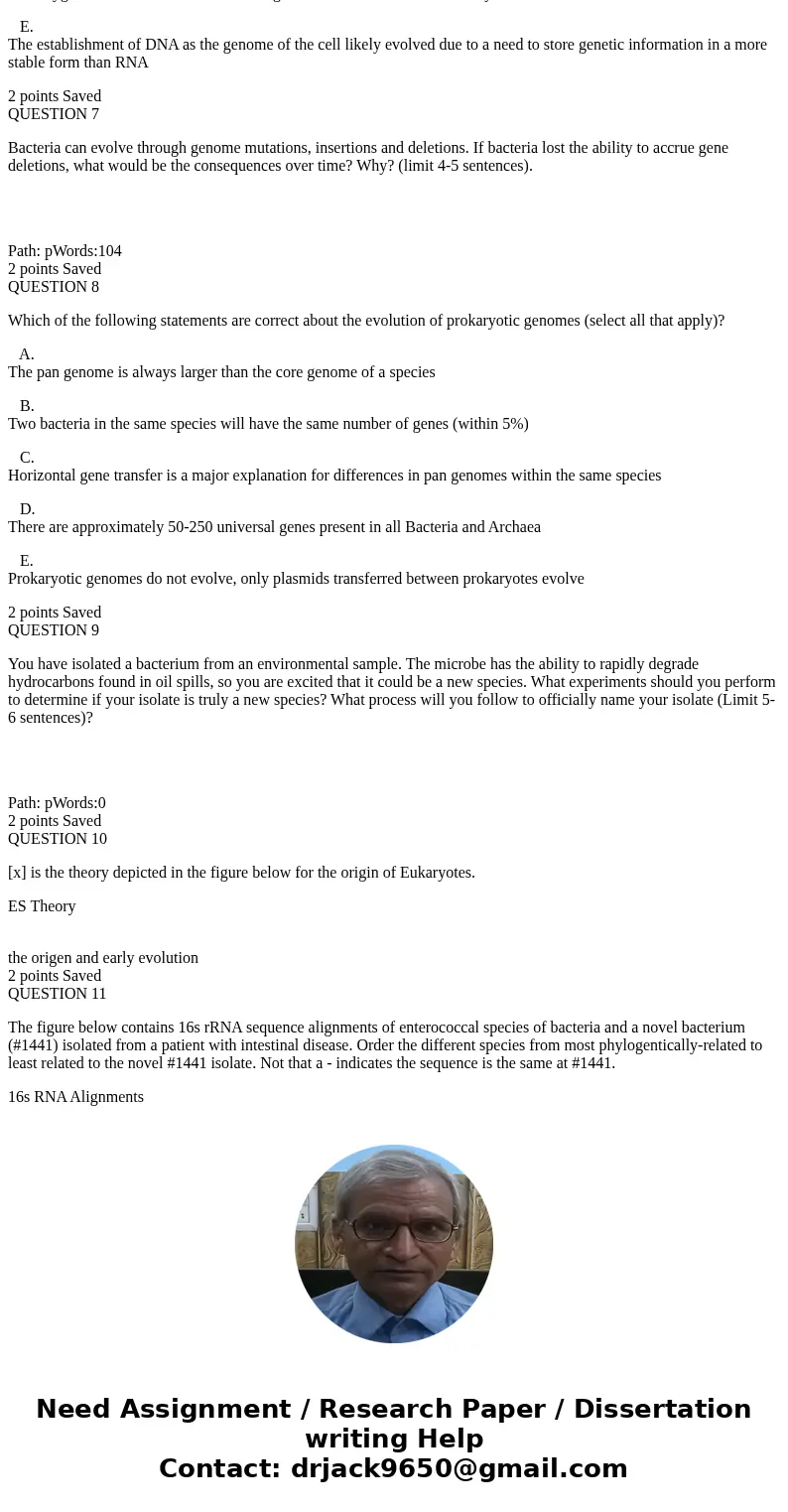
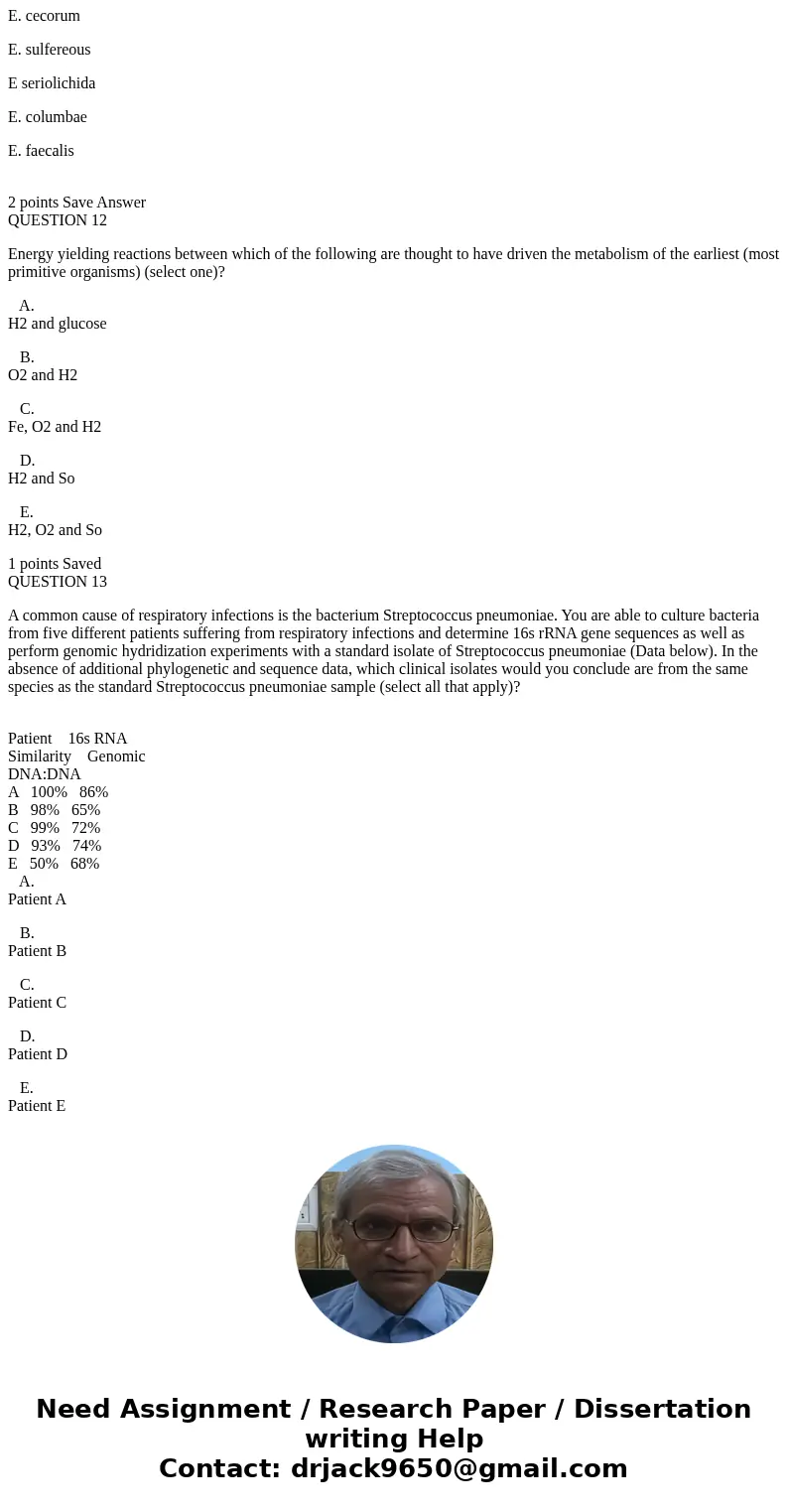
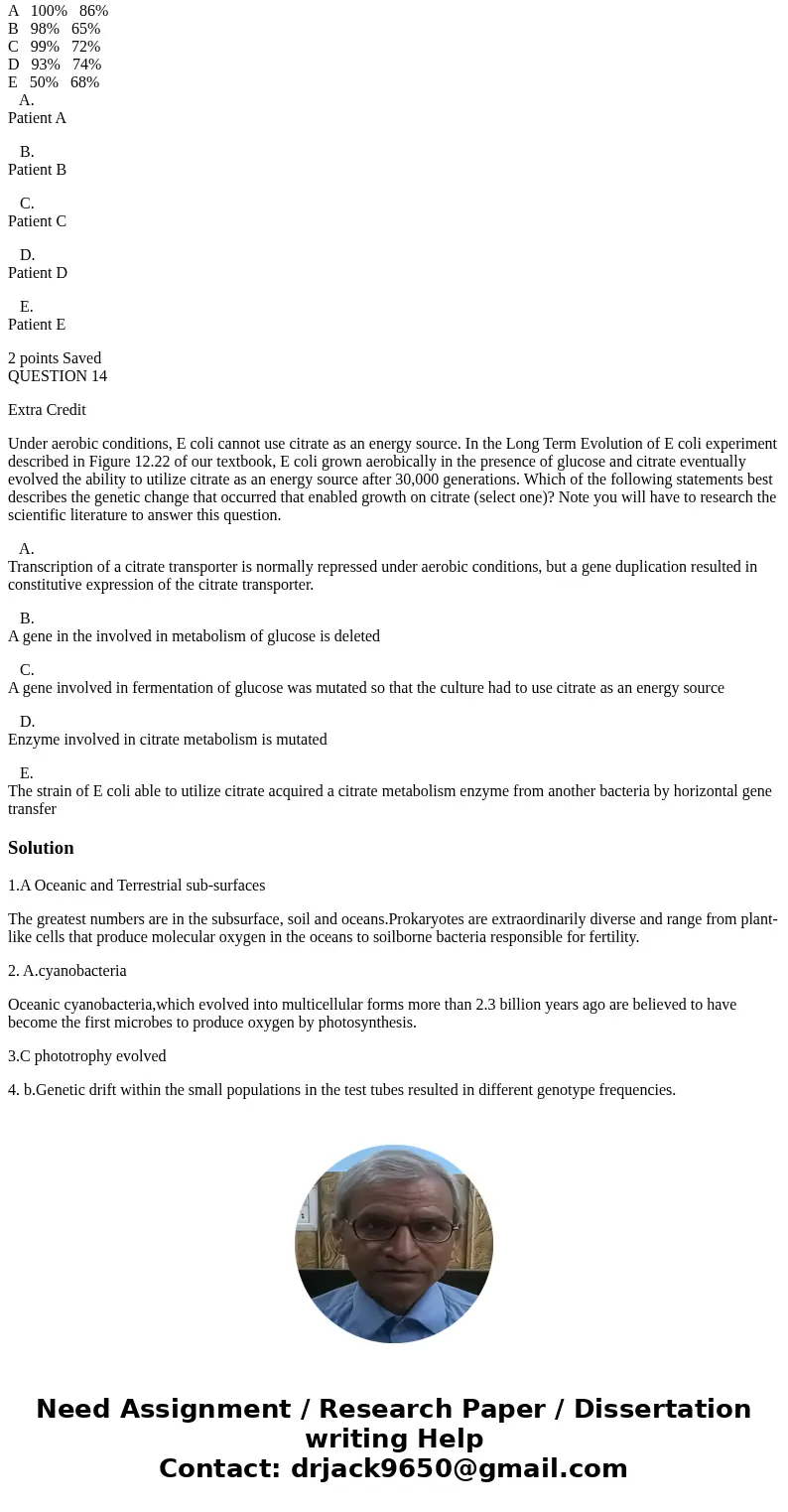
 Homework Sourse
Homework Sourse